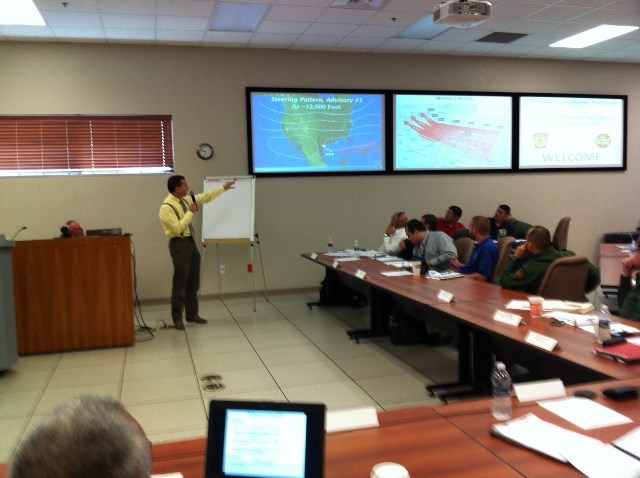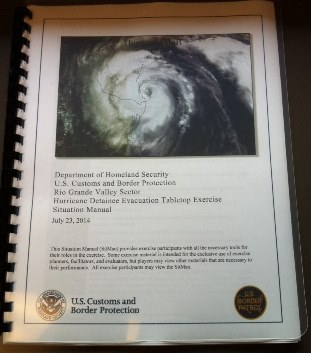 Warning Coordination Meteorologist Barry Goldsmith briefs federal, state, and local emergency management partners on potential impacts from a fictional hurricane as part of an evacuation exercise in McAllen. Click for a larger photo. |
|
| Exercise Helps Partners Plan for Special Evacuation Fictional Hurricanes Test Ability of DHS, Locals To Relocate Unaccompanied Women and Children |
|
|
McAllen, TX, July 23rd, 2014 – How would thousands of unaccompanied women and children from Central America, currently detained at facilities across the Rio Grande Valley, be moved to safety if a potentially catastrophic, large hurricane were to bear down on the region? The Department of Homeland Security/U.S. Customs and Border Protection Rio Grande Valley Sector conducted a Hurricane Detainee Evacuation Tabletop Exercise to try to get answers. The exercise consisted of four scenarios with two fictional hurricanes. The first three scenarios considered Hurricane "Duff", a western Atlantic and Gulf of America cyclone modeled after the Rio Grande Valley Labor Day Hurricane of 1933 which caused widespread sea and rainfall flooding, as well as significant wind damage. "Duff" was made larger (size) and more intense (wind) than the Labor Day Hurricane to produce more widespread wind damage and a larger storm surge in order to trigger evacuations for nearly all detention facilities in the region. Each scenario was set for critical decision times: H–120, where "H" is generally defined as the arrival time of tropical storm force wind; H–96, and H–72. An example of the decision timeline is shown in this graphic. The fourth scenario was for a meandering disturbance in the southwest Gulf of America (Bay of Campeche) that rapidly intensifies into large, intense Hurricane "Xena" within the H–48 period before making landfall along the U.S./Mexico border. For this scenario, the ability to evacuate facilities would be limited due to the logistics required to move thousands of detainees by air and ground while the general population is scrambling to complete preparedness and/or evacuate as well. This scenario was based loosely on Hurricane Bret, which passed east of the Rio Grande Valley before making landfall on the King Ranch. To begin each scenario, Warning Coordination Meteorologist Barry Goldsmith briefed audience of more than 100 decision makers on the forecast track/intensity, confidence in the forecast, and potential impacts from wind, storm surge flooding, and rainfall flooding. At longer time scales, briefings focused on overall cyclone "badness" to aid decision makers with resource allocation and movement. At shorter time scales, briefings transitioned toward potential impacts from wind, storm surge flooding, and rainfall flooding to aid decision makers on how quickly and where to move (evacuate) or not move (shelter–in–place) detainees. Following each briefing, the exercise discussed the actions needed to ensure the safety of the unaccompanied persons, whether evacuating from the Valley, or staying put. Briefing slides were collaborated among Matthew Green, Hurricane Liaison Team Manager at the National Hurricane Center in Miami, and Jennifer McNatt, Emergency Response Meteorologist/Southern Region Operational Center Team Lead in Fort Worth. The briefing slides are available here. During the detailed, shorter time scale briefings, Goldsmith mentioned the importance of knowing where the detention facilities were located relative to poor drainage areas that could make them temporarily inaccessible if several feet of water covered nearby roads; he also advised that facilities, particularly those in Hidalgo County, be evaluated for structural integrity to ensure they can stand up to hurricane force winds. "Trusted relationships among NWS Brownsville/Rio Grande Valley and core Emergency Management Partners must be cultivated often to thrive," said Goldsmith. "Exercises like these are golden opportunities to deepen trust and ensure a coordinated team effort will succeed in protecting these lives should a real, potentially devastating hurricane threaten." Participating Organizations Included:
|
|
 Juan Garces, Operations Officer, Office of Incident Management, U.S. Border Patrol Rio Grande Valley Sector (Region VI) leads a discussion on potential evacuation decisions during the Hurricane Detainee Evacuation Tabletop Exercise in McAllen. |
 Front cover of the Situation Manual used during the Hurricane Detainee Evacuation Tabletop Exercise. |